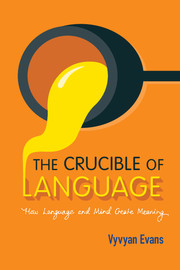Book contents
- Frontmatter
- Dedication
- Epigraph
- Contents
- List of figures
- List of tables
- Preface
- Acknowledgements
- I The ineffability of meaning
- II Meaning in mind
- Chapter 3 Patterns in language, patterns in the mind
- Chapter 4 Time is our fruit fly
- Chapter 5 Concepts body forth
- Chapter 6 The concept-making engine (or how to build a baby)
- Chapter 7 The act of creation
- III Meaning in language
- Epilogue: The golden triangle
- Notes
- References
- Index
Chapter 6 - The concept-making engine (or how to build a baby)
from II - Meaning in mind
Published online by Cambridge University Press: 05 November 2015
- Frontmatter
- Dedication
- Epigraph
- Contents
- List of figures
- List of tables
- Preface
- Acknowledgements
- I The ineffability of meaning
- II Meaning in mind
- Chapter 3 Patterns in language, patterns in the mind
- Chapter 4 Time is our fruit fly
- Chapter 5 Concepts body forth
- Chapter 6 The concept-making engine (or how to build a baby)
- Chapter 7 The act of creation
- III Meaning in language
- Epilogue: The golden triangle
- Notes
- References
- Index
Summary
In the previous chapter, I presented the case for thinking that concepts arise from embodied experience. But this raises the question: how, exactly, do concepts arise in the first place? How do we turn our everyday embodied encounters into concepts? And how does this enable a young infant to begin the slow process towards first comprehending the world, and later developing the sophisticated capacity to mean that you and I take for granted? Language, again, illuminates the challenge. The philosopher Mark Johnson, in discussing the concept of containment, describes the start of an ordinary day:
You wake out of a deep sleep and peer out from beneath the covers into your room. You gradually emerge out of your stupor, pull yourself out from under the covers, climb into your robe, stretch out your limbs, and walk in a daze out of the bedroom and into the bathroom. You look in the mirror and see your face staring out at you. You reach into the medicine cabinet, take out the toothpaste, squeeze out some toothpaste, put the toothbrush into your mouth, brush your teeth in a hurry, and rinse out your mouth.
The recurrent use of the expressions in and out in this passage – which I've highlighted in italics – reveals something quite striking. A great number of everyday objects and experiences are categorised as specific instances of the schematic concept Container: not only obvious containers such as bathroom cabinets and toothpaste tubes, but also less obvious containers such as bed-covers, clothing and rooms, and even states such as sleep, stupor and daze.
This reveals that spatial information appears to form the bedrock of many of our everyday concepts. While it is perhaps obvious that we should conceptualise a bathroom cabinet as a container, it is less clear that more abstract concepts like being in a state of sleep can also be thought of, at least in part, as a container. But this is exactly what our everyday language suggests. In Chapter 3, I showed how conceptual metaphor enables abstract concepts to be structured in terms of more concrete sensory–motor experiences. And in this way the human conceptual system is enriched, facilitating, in part, the full panoply of concepts upon which language depends, and which we take for granted in our daily lives and encounters.
- Type
- Chapter
- Information
- The Crucible of LanguageHow Language and Mind Create Meaning, pp. 122 - 153Publisher: Cambridge University PressPrint publication year: 2015



